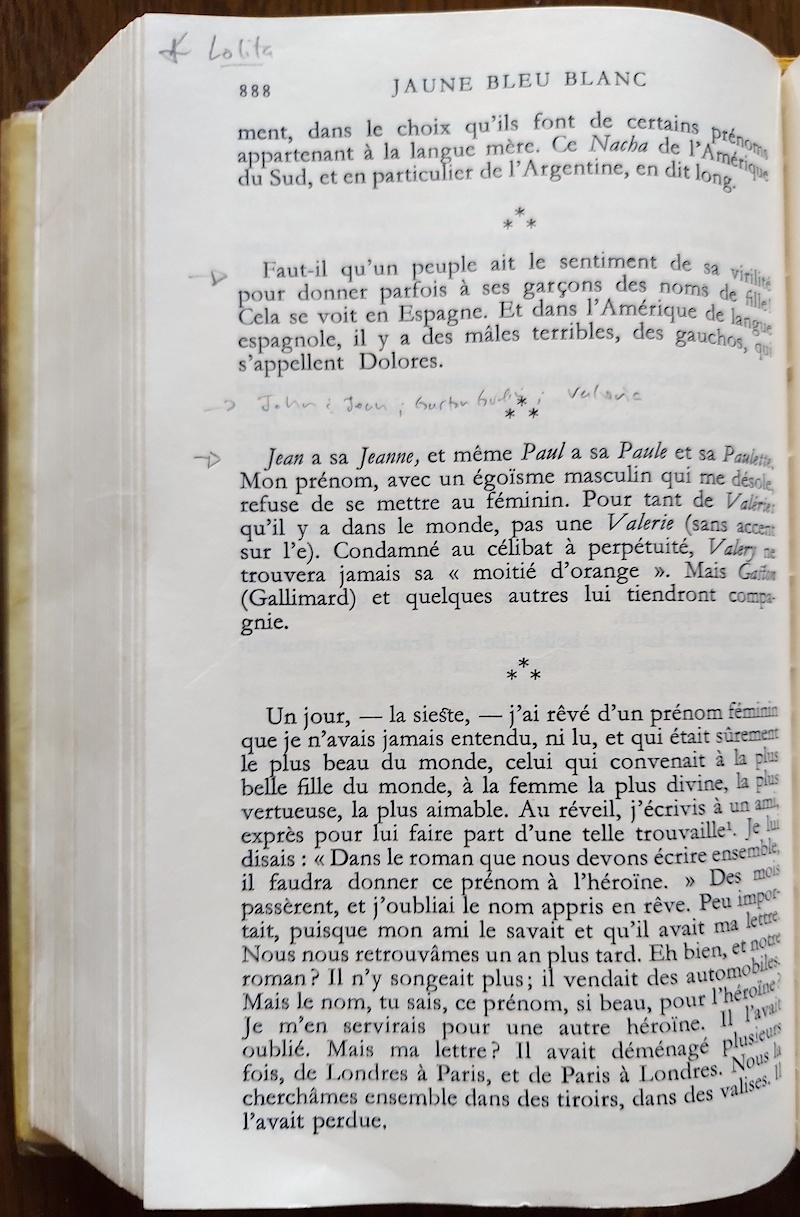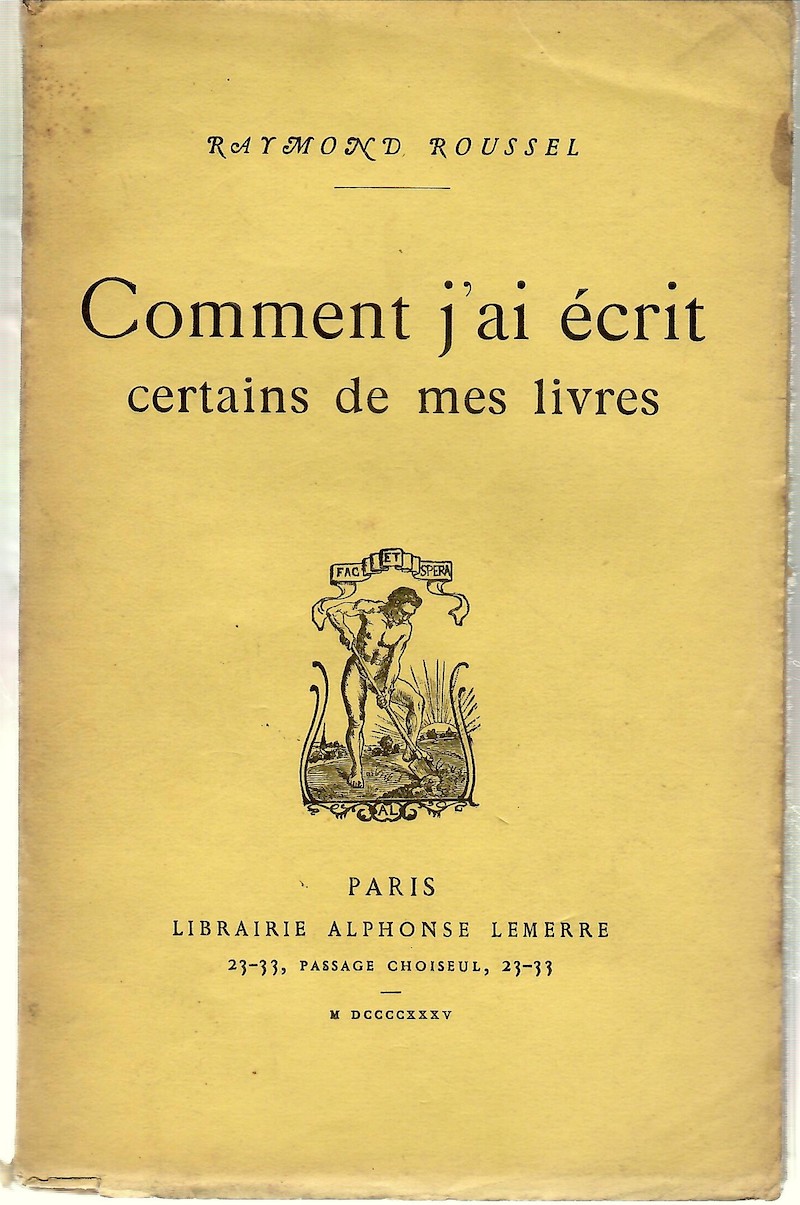Le plagiat est nécessaire. Le progrès l’implique. Il serre de près la phrase d’un auteur, se sert de ses expressions, efface une idée fausse, la remplace par l’idée juste.
Une maxime, pour être bien faite, ne demande pas à être corrigée. Elle demande à être développée.
(Ducasse 1870: 6).
There are not many such books.
(Nabokov 1958: 317).
There are not many such books.
(Wells 1909: 174).
Il sonna, aperçut un geste sous un rideau levé, entra.Il s’essuya poliment les pieds. Madeleine le débarrassa de ses vêtements chargés d’une poudre glacée. Un pas léger se fit entendre dans l’escalier et Bernard sentit se presser contre lui un petit corps chaud et vibrant, une flamme.
— Annette, murmura-t-il, ma vie, ma vie, ma vie.
Dehors il n’avait jamais fait aussi froid. (Queneau 1939: 15, 175).
Lolita, light of my life, fire of my loins. My sin, my soul. Lo-lee-ta: the tip of the tongue taking a trip of three steps down the palate to tap, at three, on the teeth. Lo. Lee. Ta. (Lolita I, § 1, 11).I read Lolita again in April 2000, then again in July 2001 after moving back to Philadelphia, then a fifth time, in Alfred Appel, Jr.’s annotated edition, in September 2005 after having read Un rude hiver for the second time earlier the same month. Only after using this observation as the basis for the first posting to my Nabokov’s Infernos blog on September 17, 2008, did I discover Paul Braffort’s confirmation of this “relation ‘oblique’ entre Un rude hiver et Lolita” in his article “Les quatre petites filles” which seems to date from 2002.
Reçu «avec toute confiance», en ami de la maison, je ne tarde pas à appeler: Dolores? Un jour, inspiré par l’amour, je murmurai: Lola. Et, le soir des noces, j’aurai Lolita dans me bras. C’est le principe; mais il y a aussi des formes, et des déformations, locales: Loliú, Lolin... La gamme entière. (Larbaud 1958: 889).
She was Lo, plain Lo, in the morning, standing four feet ten in one sock. She was Lola in slacks. She was Dolly at school. She was Dolores on the dotted line. But in my arms she was always Lolita. (Lolita I, § 1, 11).And with the names of Jean and John Farlow, Gaston Godin, and Valeria — the Slavic “soothing presence,” the “glorified pot-au-feu,” the “animated merkin” (Lolita I, § 8, 27) Humbert took as his first wife, aka “Valéry” and not “Valery” (as Nabokov took pains to correct [see Nabokov and Bruccoli 1989: 169]) in the 1955 Olympia Press first edition of Lolita — fresh in mind, I could not fail to notice another onomastic constellation of interest on the facing page:
Jean a sa Jeanne, et même Paul a sa Paule et sa Paulette. Mon prénom, avec un égoïsme masculin qui me désole, refuse de se mettre au féminin. Pour tant de Valéries qu’il y a dans le monde, pas une Valerie (sans accent sur l’e). Condamné au célibat à perpétuité, Valery ne trouvera jamais sa «moitié d’orange». Mais Gaston (Gallimard) et quelques autres lui tiendront compagnie. (Larbaud 1958: 888)
He still read books when he had a chance, books that told of glorious places abroad and glorious times, that wrung a rich humour from life and contained the delight of words freshly and expressively grouped. But alas! there are not many such books, and for the newspapers and the cheap fiction that abounded more and more in the world Mr. Polly had little taste. (Wells 1909: 173–174).
For me a work of fiction exists only insofar as it affords me what I shall bluntly call aesthetic bliss, that is a sense of being somehow, somewhere, connected with other states of being where art (curiosity, tenderness, kindness, ecstasy) is the norm. There are not many such books. All the rest is either topical trash or what some call the Literature of Ideas, which is very often topical trash coming in huge blocks of plaster that are carefully transmitted from age to age until somebody comes along with a hammer and takes a good crack at Balzac, at Gorki, at Mann. (Lolita, On a book entitled Lolita, 316–317).Now, in addition to Nabokov’s statement also potentially “alluding” to a similar passage occurring later in Mr. Polly (the parenthetical kiks indicate an idiosyncrasy of the interlocutor’s vocal apparatus):
His literary admirations were not precisely Mr. Polly’s literary admirations; he thought books were written to enshrine Great Thoughts, and that art was pedagogy in fancy dress, he had no sense of phrase or epithet or richness of texture, but still he knew there were books, he did know there were books and he was full of large windy ideas of the sort he called “Modern (kik) Thought,” and seemed needlessly and helplessly concerned about “(kik) the Welfare of the Race.” (Wells 1909: 195).as well as to a motif whose variants occur both in Nietzsche’s preface to his Twilight of the Idols and in an anecdote Larbaud’s A. O. Barnabooth recounts anent his friend Maxime Claremoris, dit Le Pèlerin:
There are more idols than realities in the world [...] For once to pose questions here with a hammer, and, perhaps, to hear as a reply that famous hollow sound which speaks of bloated entrails [...] and regarding the sounding out of idols, this time they are not just idols of the age, but eternal idols, which are here touched with a hammer as with a tuning fork: there are altogether no older, no more convinced, no more puffed-up idols — and none more hollow. (Nietzsche 1889: Preface, 465–466).
Il me disait comment il avait réussi à «supprimer un peu de laideur». Il achète toute la «bondieuserie» que ses moyens lui permettent d’acheter, «les saint Jean et les saint Joseph en biscuit; tu sais, ces saint Joseph qui ont l’air de sortir de la boutique d’un coiffeur de campagne»; il les casse à coups de marteau, et les réduit en menus morceaux qu’il jette ensuite aux latrines (j’aurais beaucoup à lui dire, là-dessus aussi). (Larbaud 1958: 100).it seemed here that Nabokov, by so brazenly opening himself to a potential charge of plagiary, was admitting to doing precisely that; that is, providing a clue as to how he wrote, if not all of his books, at least certain of them, Lolita in particular.
Jansy Mello’s intuition anent the patchwork or mosaic or centonian nature of Lolita seems quite apt. A collaborative project aimed at tracking down the novel’s various tesserae may be called for. Such a project could have for title something like “Nabokov’s Quilt: Lolita as Patchwork” or “Nabokov’s Quilt: Lolita as Cento.” Maurice Couturier’s insights concerning the use of the name Lolita among early 20th century French novelists would be included: “Isidore Gès’s En villégiature. Lolita published in 1894, René Riche’s La Chanson de Lolita published in 1920 which obviously refers to Pierre Louÿs’s Chanson de Bilitis (1894) which itself celebrated nymphets. And Valéry [sic] Larbaud’s passage on the name of Lolita in his Des prénoms féminins (1927) has often been quoted” [NABOKV-L posting of April 2, 2004]. Perhaps we should add Marcel Schwob’s Le livre de Monelle to the list, and mention in passing that, in the first edition of Lolita, the drugstore where Bill’s wife “used to secretly admire the famous young actor as he ate sundaes” was called Schwob’s [Lolita I, 32].My observations of similarities between Nabokov’s Lolita and Wells’s Apropos of Dolores, as well as Rainwater’s skewed ditto, were quickly confirmed by Penny McCarthy in a post to the NABOKV-L on June 13:We might also like to expand upon and refine Mary Catherine Rainwater’s observations concerning the structural and thematic links between Lolita (and its Russian precursor) and H. G. Wells’s Apropos of Dolores (1938) [Mary Catherine Rainwater, Twentieth-Century Writers in the Poe Tradition: Wells, Bowles, and Nabokov. PhD dissertation, The University of Texas at Austin, 1982]. (We will have to make an important emendation to Rainwater’s thesis. Rainwater states that “Dolores ‘Lolita’ Haze derives from Wells’s Dolores” [p. 238] and that “Nabokov fashions Lolita after Wells’s Dolores almost as much as after Poe’s Annabel Lee” [pp. 239-240]. This contention is surely false. Although the narrator of Apropos of Dolores, Stephen Wilbeck, meets his Dolores in circumstances quite similar to those in which Humbert Humbert meets his Annabel Leigh, the Dolores whom Wilbeck meets is long past her nymphettage, if ever she had been a member of that species. No. Wells’s Dolores is a member of the same species as “the Haze woman,” Charlotte. That being said, we may note that Stephen Wilbeck has a daughter from a previous marriage, Lettice. Lettice, alas, is not a nymphet. However, Apropos of Dolores indirectly implies that the relationship between Wilbeck and Lettice borders, at least, on the incestuous: Wilbeck’s attitude towards Lettice seems to be more romantic than paternal, and Wilbeck’s cousin John, under the influence of Dolores’s “nasty imagination” [Wells, Apropos of Dolores, IV, 7: 138], accuses Wilbeck of having an affair with his “own flesh and blood” [Wells, Apropos of Dolores, IV, 7: 137]. Wilbeck denies the accusation. In addition, after Dolores dies unexpectedly (in a manner that parallels the deus ex machina that conveniently removes Charlotte), Wilbeck sends for his daughter (whom he has not seen for several years) and they embark on a tour of Brittany (Armorica). Lettice is quite unlike the elegant and refined young lady Wilbeck had imagined: her conversation consists mostly of the monosyllable “Urm.”)
In our collaborative work, we may also wish to mention that Humbert pens his confession in order to assist his case in an imaginary (or infernal) trial and that the equally unreliable narrator of the Wells novel pens his confession as the “Case of Stephen Wilbeck contra Dolores” in preparation for divorce proceedings that never materialize since Dolores suddenly dies (or does Wilbeck murder her?).
Furthermore, we may wish to interpret Nabokov’s afterword as a signpost pointing to other tessellae:
“There was a spacious, bright Jardin des Plantes with nice unhurried-looking people sitting about, more old ladies in lovely white caps, and children playing and being reproved, and various of those rotund groups of sculptures just for the sake of sculpture, all breasts and thighs and bottoms and sprawl, with which France abounds.” [Wells, Apropos of Dolores, I, 2: 7.]
“The other day, just before I started upon this trip, I spent half an hour in silent and sympathetic proximity to a big rusty-red orang-outang in the Jardin d’Acclimatation. He is that sort of orang-outang which has a flat expansion of the cheeks on either side so that its face, so far as its lower parts are concerned, looks like a mask. It seems to wear those huge jaws and lips like something that has been imposed upon it, and over them very intelligently light-brown eyes look out with an expression of patient resignation upon the world. So it has pleased God. Sometimes those quiet eyes would scrutinize me, mildly speculative, sometimes they watched other spectators or brooded upon the baboons in an adjacent cage, whose sins were as scarlet. // My sage moved rarely, to scratch his chest or his arm thoughtfully and once to yawn. But even in captivity and already perhaps mortally sick, for these great apes acquire tuberculosis and suchlike human infections with a terrible readiness, he gave no sign of unhappiness. Those little hazel eyes were wise and tranquil. Captive and ill, he had every reason to be unhappy, but I do not think he was unhappy. If I could have changed consciousness with him and got into that cokernut head of his, I think I should have perceived small weak childish interest in spectators and baboons — like a child looking out of a window — little imaginations set going by these sights and nothing else. I doubt if he was worried and distressed in the least by his captivity. Quite possibly, but not certainly, he would have been happier in his native forest, but he did not know that. He had forgotten his native forest, or remembered it and the parental nest only in dreams. There may have been terror in these dreams and it may have been reassuring to wake in the large secure cage again. I think he was still to be counted as a mild fragment of at least contentment.” [Wells, Apropos of Dolores, II, 2: 24–25.]
In connection with Michael Strickland’s ‘tesserae’: in the latest issue of The Nabokovian (56, Spring 2006, pp. 38–48) is my piece ‘Lolita: Wellsprings and Influences’, which traces connections between Apropos of Dolores and Lolita. I’m afraid I did not know of the unpublished thesis — mea culpa. I have some of Strickland’s lines of filiation, and some others (the a propos, motoring, dentists, perfumer traders, techniques, verbal echoes, French, monkeys).I responded a week later, on June 20, with the following post:
In her article in the latest issue of The Nabokovian, Penny McCarthy elucidates several connections between Apropos of Dolores by H. G. Wells and Nabokov’s Lolita. Her mention of R. L Stevenson as another source of Nabokov’s simian imagery set off a chain of speculation starting from “Otto Otto” (Lolita, p. 310) and extending perhaps to Pale Fire:All of this collecting of coincidences, similarities, filiations, allusions, tessellae, tesserae, and so on, could (and does) go on ad infinitum, but without some sort of guiding principle, it is really beside the point, since it can only result in either further demonstrations of Nabokov’s (and by association, the scholar’s) erudite virtuosity, or, for the literal-minded critical acolyte of the cult of “originality,” a sly or shameful skewering of the maestro’s genius, since — gasp! — he was really just a playful plagiarist. The missing principle, of course, is Raymond Roussel’s procédé.In Chapter III, section 6 of Apropos of Dolores, the narrator writes: “Now that I find myself setting down my case of Stephen Wilbeck contra Dolores I am astonished at the extremely poor quality of the evidence produced by my one and only witness, myself. And yet the publisher of Otto Jensen’s Reality of Evidence ought to have known better.”
This reminded me that R. L. Stevenson wrote a romance called Prince Otto (originally published in 1885; an online version is available at gutenberg.org).
In Book II, chapter IV of Prince Otto, we find the following:
“The Countess von Rosen had hitherto been silent, and a thought depressed, but on the approach of Otto she began to brighten. She was tall, slim as a nymph, and of a very airy carriage; and her face, which was already beautiful in repose, lightened and changed, flashed into smiles, and glowed with lovely colour at the touch of animation. She was a good vocalist; and, even in speech, her voice commanded a great range of changes, the low notes rich with tenor quality, the upper ringing, on the brink of laughter, into music. A gem of many facets and variable hues of fire; a woman who withheld the better portion of her beauty, and then, in a caressing second, flashed it like a weapon full on the beholder; now merely a tall figure and a sallow handsome face, with the evidences of a reckless temper; anon opening like a flower to life and colour, mirth and tenderness: — Madame von Rosen had always a dagger in reserve for the despatch of ill-assured admirers. She met Otto with the dart of tender gaiety.”
This passage has nothing to do with Lolita, of course — except for the coincidence of the words “nymph” and “sallow” (but alas! no nymphets anywhere!) and the phonetic echo of von Rosen with Lolita’s friend Eva Rosen (an echo made more resonant when, later in the book, Madame Countess von Rosen likens herself to “Vivien”).
A further Lolita-esque coincidence occurs in book II, chapter XIII: Madame von Rosen, speaking with Princess Seraphina, says, “I am going to insult you, to betray one who is called my lover, and if it pleases you to use the power I now put unreservedly into your hands, to ruin my dear self. O what a French comedy! You betray, I betray, they betray. It is now my cue.”
A revolution ensues in the Republic and Principality of Grunewald. In book III, chapter I of Prince Otto, Princess Seraphina is forced to flee the palace in circumstances very similar (an anti-parody by anticipation of sorts) to those encountered by the King when he was forced to flee Zembla.
At the end of Prince Otto, R. L. Stevenson tacks a “Bibliographic Postscript to complete the story” which contains some pleasing mimicries of scholarship concerning the fate of the ex-Republic of Grunewald.





